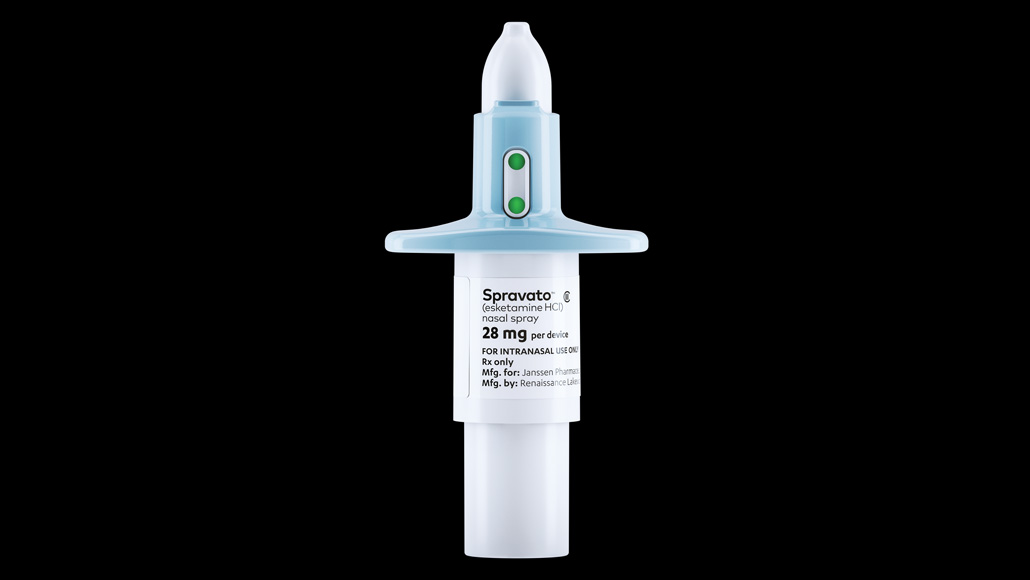In 2019, a ketamine-based antidepressant raised hopes and concerns
The benefits and risks of Spravato are not yet clear

The antidepressant Spravato can be taken only at certified health clinics, to allow for close patient monitoring.
Janssen Pharmaceuticals, Inc.
- More than 2 years ago
For the first time in decades, a fundamentally new drug became available for people with severe depression. A nasal spray called Spravato offers a new option for treating people whose depression hasn’t responded to other approaches. But there are still big questions about the drug’s effectiveness and safety (SN: 4/13/19, p. 8).
In March, the U.S. Food and Drug Administration approved Spravato. The drug contains esketamine, one of two mirror-image molecules that make up the drug ketamine. Developed decades ago as a powerful anesthetic, ketamine is also a hallucinogen co-opted by ravers and other partiers for its swirly, out-of-body highs.
Many existing antidepressants target serotonin, a chemical messenger in the brain involved in mood. Scientists think ketamine and its relatives affect a different chemical messenger, glutamate, sometimes within hours.
For all the fanfare over Spravato’s approval, ketamine’s power to quickly turn around severe depression in some people has been known for years. Freestanding clinics, as well as academic medical centers, offer intravenous infusions of ketamine to people with severe depression. For some patients, the treatment has been life-changing. Yet others don’t respond. “It’s not for everybody,” says Cristina Cusin, a psychiatrist who codirects the ketamine clinic at Massachusetts General Hospital in Boston.
Spravato received fast-track approval from the FDA based on what some critics call weaker-than-usual evidence: In two of three monthlong trials, Spravato didn’t outperform a placebo, for instance. Janssen Pharmaceuticals, the drug’s maker, is still tallying data and trying to determine which patients might be helped most by the drug.
Sign up for our newsletter
We summarize the week's scientific breakthroughs every Thursday.
On September 9, the company reported mixed results from two drug trials involving 456 people who were suicidal and hospitalized with severe depression. All participants received standard care, which included treatment with a standard antidepressant. On top of that, some people also received Spravato, while others took a placebo.
Twenty-four hours after beginning treatment, the people taking Spravato scored on average almost four points lower on a 60-point depression scale than people who had received a placebo — a small but consistent difference. Yet, suicidal behavior did not differ between people who took Spravato and those who took the placebo; both groups improved.
Spravato comes with a long list of side effects: sleepiness, dizziness, anxiety and feelings of disconnection, vomiting, increased blood pressure and bladder problems. And like ketamine, Spravato can be abused. For these reasons, the FDA requires that the drug be taken only in a certified health clinic, so the patient can be monitored for several hours after using it.
As of mid-October, more than 2,000 clinical sites had been certified to dispense Spravato, according to Janssen. A typical schedule might include twice-a-week doses for the first month, then a gradual tapering. The drug’s estimated price is about $32,000 for a year, which doesn’t include the costs of clinic time required for monitoring. It’s unclear whether or how insurance companies will cover Spravato, Cusin says, though the U.S. Department of Veterans Affairs is offering the drug in limited cases.
Researchers are pushing ahead on other ketamine offshoots. Early studies in lab animals suggest that arketamine, the mirror image of esketamine, and breakdown products of ketamine could be turned into drugs that are effective and have fewer side effects than ketamine or esketamine.
The National Suicide Prevention Lifeline can be reached at 1-800-273-TALK (8255).







